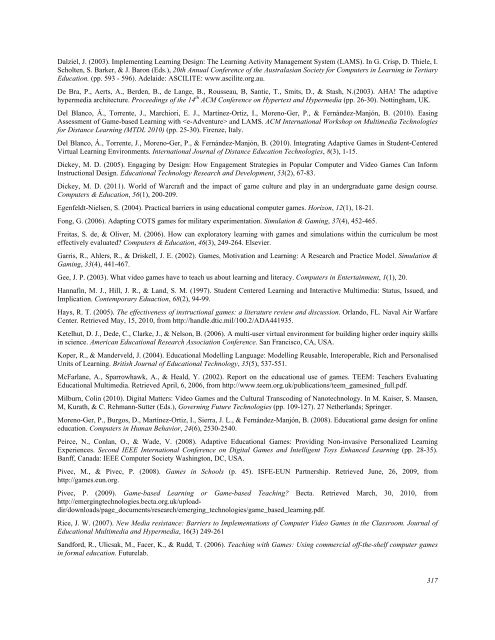October 2012 Volume 15 Number 4 - Educational Technology ...
October 2012 Volume 15 Number 4 - Educational Technology ...
October 2012 Volume 15 Number 4 - Educational Technology ...
You also want an ePaper? Increase the reach of your titles
YUMPU automatically turns print PDFs into web optimized ePapers that Google loves.
Dalziel, J. (2003). Implementing Learning Design: The Learning Activity Management System (LAMS). In G. Crisp, D. Thiele, I.<br />
Scholten, S. Barker, & J. Baron (Eds.), 20th Annual Conference of the Australasian Society for Computers in Learning in Tertiary<br />
Education. (pp. 593 - 596). Adelaide: ASCILITE: www.ascilite.org.au.<br />
De Bra, P., Aerts, A., Berden, B., de Lange, B., Rousseau, B, Santic, T., Smits, D., & Stash, N.(2003). AHA! The adaptive<br />
hypermedia architecture. Proceedings of the 14 th ACM Conference on Hypertext and Hypermedia (pp. 26-30). Nottingham, UK.<br />
Del Blanco, Á., Torrente, J., Marchiori, E. J., Martínez-Ortiz, I., Moreno-Ger, P., & Fernández-Manjón, B. (2010). Easing<br />
Assessment of Game-based Learning with and LAMS. ACM International Workshop on Multimedia Technologies<br />
for Distance Learning (MTDL 2010) (pp. 25-30). Firenze, Italy.<br />
Del Blanco, Á., Torrente, J., Moreno-Ger, P., & Fernández-Manjón, B. (2010). Integrating Adaptive Games in Student-Centered<br />
Virtual Learning Environments. International Journal of Distance Education Technologies, 8(3), 1-<strong>15</strong>.<br />
Dickey, M. D. (2005). Engaging by Design: How Engagement Strategies in Popular Computer and Video Games Can Inform<br />
Instructional Design. <strong>Educational</strong> <strong>Technology</strong> Research and Development, 53(2), 67-83.<br />
Dickey, M. D. (2011). World of Warcraft and the impact of game culture and play in an undergraduate game design course.<br />
Computers & Education, 56(1), 200-209.<br />
Egenfeldt-Nielsen, S. (2004). Practical barriers in using educational computer games. Horizon, 12(1), 18-21.<br />
Fong, G. (2006). Adapting COTS games for military experimentation. Simulation & Gaming, 37(4), 452-465.<br />
Freitas, S. de, & Oliver, M. (2006). How can exploratory learning with games and simulations within the curriculum be most<br />
effectively evaluated? Computers & Education, 46(3), 249-264. Elsevier.<br />
Garris, R., Ahlers, R., & Driskell, J. E. (2002). Games, Motivation and Learning: A Research and Practice Model. Simulation &<br />
Gaming, 33(4), 441-467.<br />
Gee, J. P. (2003). What video games have to teach us about learning and literacy. Computers in Entertainment, 1(1), 20.<br />
Hannafin, M. J., Hill, J. R., & Land, S. M. (1997). Student Centered Learning and Interactive Multimedia: Status, Issued, and<br />
Implication. Contemporary Eduaction, 68(2), 94-99.<br />
Hays, R. T. (2005). The effectiveness of instructional games: a literature review and discussion. Orlando, FL. Naval Air Warfare<br />
Center. Retrieved May, <strong>15</strong>, 2010, from http://handle.dtic.mil/100.2/ADA441935.<br />
Ketelhut, D. J., Dede, C., Clarke, J., & Nelson, B. (2006). A multi-user virtual environment for building higher order inquiry skills<br />
in science. American <strong>Educational</strong> Research Association Conference. San Francisco, CA, USA.<br />
Koper, R., & Manderveld, J. (2004). <strong>Educational</strong> Modelling Language: Modelling Reusable, Interoperable, Rich and Personalised<br />
Units of Learning. British Journal of <strong>Educational</strong> <strong>Technology</strong>, 35(5), 537-551.<br />
McFarlane, A., Sparrowhawk, A., & Heald, Y. (2002). Report on the educational use of games. TEEM: Teachers Evaluating<br />
<strong>Educational</strong> Multimedia. Retrieved April, 6, 2006, from http://www.teem.org.uk/publications/teem_gamesined_full.pdf.<br />
Milburn, Colin (2010). Digital Matters: Video Games and the Cultural Transcoding of Nanotechnology. In M. Kaiser, S. Maasen,<br />
M, Kurath, & C. Rehmann-Sutter (Eds.), Governing Future Technologies (pp. 109-127). 27 Netherlands; Springer.<br />
Moreno-Ger, P., Burgos, D., Martínez-Ortiz, I., Sierra, J. L., & Fernández-Manjón, B. (2008). <strong>Educational</strong> game design for online<br />
education. Computers in Human Behavior, 24(6), 2530-2540.<br />
Peirce, N., Conlan, O., & Wade, V. (2008). Adaptive <strong>Educational</strong> Games: Providing Non-invasive Personalized Learning<br />
Experiences. Second IEEE International Conference on Digital Games and Intelligent Toys Enhanced Learning (pp. 28-35).<br />
Banff, Canada: IEEE Computer Society Washington, DC, USA.<br />
Pivec, M., & Pivec, P. (2008). Games in Schools (p. 45). ISFE-EUN Partnership. Retrieved June, 26, 2009, from<br />
http://games.eun.org.<br />
Pivec, P. (2009). Game-based Learning or Game-based Teaching? Becta. Retrieved March, 30, 2010, from<br />
http://emergingtechnologies.becta.org.uk/uploaddir/downloads/page_documents/research/emerging_technologies/game_based_learning.pdf.<br />
Rice, J. W. (2007). New Media resistance: Barriers to Implementations of Computer Video Games in the Classroom. Journal of<br />
<strong>Educational</strong> Multimedia and Hypermedia, 16(3) 249-261<br />
Sandford, R., Ulicsak, M., Facer, K., & Rudd, T. (2006). Teaching with Games: Using commercial off-the-shelf computer games<br />
in formal education. Futurelab.<br />
317

















